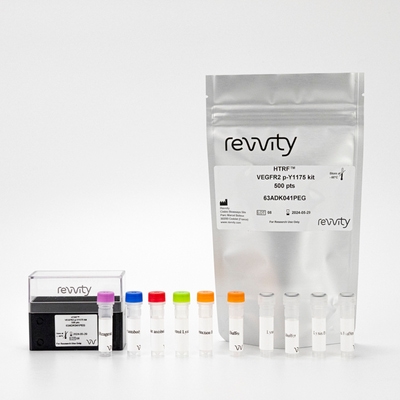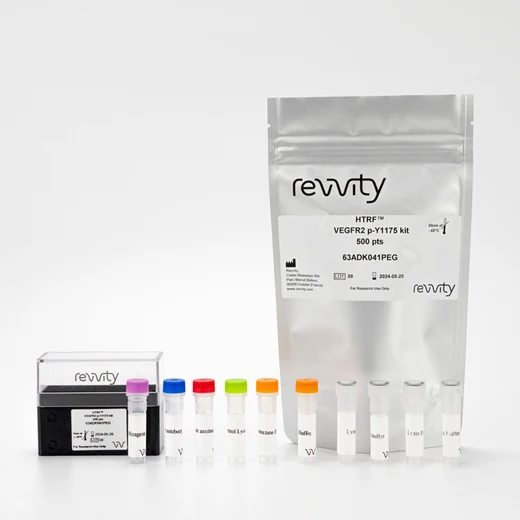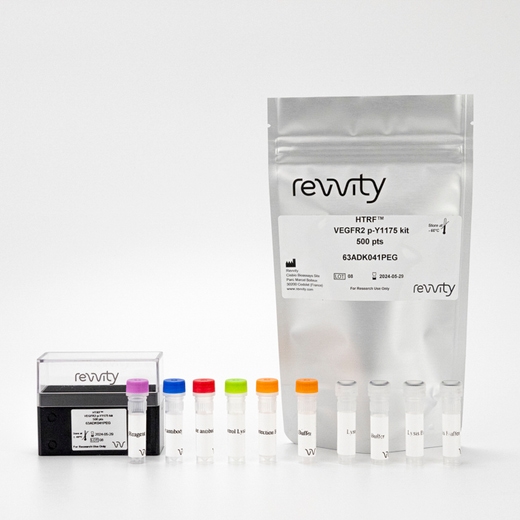

HTRF Human Phospho-VEGF receptor 2 (VEGFR2) (Tyr1175) Detection Kit, 500 Assay Points


HTRF Human Phospho-VEGF receptor 2 (VEGFR2) (Tyr1175) Detection Kit, 500 Assay Points






The phospho-VEGFR2 (Tyr1175) kit is designed to enable quantitative detection of the modulation of the VEGF receptor 2, phosphorylated on Tyrosine 1175.
For research use only. Not for use in diagnostic procedures. All products to be used in accordance with applicable laws and regulations including without limitation, consumption and disposal requirements under European REACH regulations (EC 1907/2006).
| Feature | Specification |
|---|---|
| Application | Cell Signaling |
| Sample Volume | 16 µL |
The phospho-VEGFR2 (Tyr1175) kit is designed to enable quantitative detection of the modulation of the VEGF receptor 2, phosphorylated on Tyrosine 1175.
For research use only. Not for use in diagnostic procedures. All products to be used in accordance with applicable laws and regulations including without limitation, consumption and disposal requirements under European REACH regulations (EC 1907/2006).



HTRF Human Phospho-VEGF receptor 2 (VEGFR2) (Tyr1175) Detection Kit, 500 Assay Points



HTRF Human Phospho-VEGF receptor 2 (VEGFR2) (Tyr1175) Detection Kit, 500 Assay Points



Product information
Overview
Homogeneous cell-based assay for monitoring phospho-VEGFR2 (Tyr1175) modulations. VEGFR2 mediated signaling data has uses in angiogenesis, vascular permeability and cancer stem cell regulation research.
Specifications
| Application |
Cell Signaling
|
|---|---|
| Brand |
HTRF
|
| Detection Modality |
HTRF
|
| Lysis Buffer Compatibility |
Lysis Buffer 1
Lysis Buffer 2
Lysis Buffer 3
Lysis Buffer 4
Lysis Buffer 5
|
| Molecular Modification |
Phosphorylation
|
| Product Group |
Kit
|
| Sample Volume |
16 µL
|
| Shipping Conditions |
Shipped in Dry Ice
|
| Target Class |
Phosphoproteins
|
| Target Species |
Human
|
| Technology |
TR-FRET
|
| Therapeutic Area |
Cardiovascular
NASH/Fibrosis
Neuroscience
Oncology & Inflammation
|
| Unit Size |
500 Assay Points
|
Video gallery

HTRF Human Phospho-VEGF receptor 2 (VEGFR2) (Tyr1175) Detection Kit, 500 Assay Points

HTRF Human Phospho-VEGF receptor 2 (VEGFR2) (Tyr1175) Detection Kit, 500 Assay Points

Citations
How it works
Phospho-VEGFR2 (Tyr1175) assay principle
The Phospho-VEGFR2 (Tyr1175) assay measures VEGFR2 when phosphorylated at Tyr1175. Contrary to Western Blot, the assay is entirely plate-based and does not require gels, electrophoresis or transfer. The Phospho-VEGFR2 (Tyr1175) assay uses 2 labeled antibodies: one with a donor fluorophore, the other one with an acceptor. The first antibody is selected for its specific binding to the phosphorylated motif on the protein, the second for its ability to recognize the protein independent of its phosphorylation state. Protein phosphorylation enables an immune-complex formation involving both labeled antibodies and which brings the donor fluorophore into close proximity to the acceptor, thereby generating a FRET signal. Its intensity is directly proportional to the concentration of phosphorylated protein present in the sample, and provides a means of assessing the proteins phosphorylation state under a no-wash assay format.

Phospho-VEGFR2 (Tyr1175) 2-plate assay protocol
The 2 plate protocol involves culturing cells in a 96-well plate before lysis then transferring lysates to a 384-well low volume detection plate before adding phospho-VEGFR2 (Tyr1175)HTRF detection reagents. This protocol enables the cells' viability and confluence to be monitored.

Phospho-VEGFR2 (Tyr1175) 1-plate assay protocol
Detection of phosphorylated VEGFR2 with HTRF reagents can be performed in a single plate used for culturing, stimulation and lysis. No washing steps are required. This HTS designed protocol enables miniaturization while maintaining robust HTRF quality.

Assay validation
Human VEGF stimulation on Huvec cells leads phosphorylation on VEGFR2 protein on tyrosine 1175 residue
HUVEC cells were plated at various cellular densities on a 96-well plate. After overnight incubation at 37°C and 5% CO2, a serial dilution of human VEGF was added for 3 minutes at 37°C and 5% CO2. Stimulation medium was removed from cells and 50µL of lysis buffer was added onto the cells. The lysis step was done by shaking gently for 30 minutes. 16µL of samples were transferred to a 384-well small volume plate, then 4µL of Phospho VEGFR2 HTRF detection reagents were added. Signals were recorded overnight. The assay window increased as cellular density increased.

Stimulation kinetic of VEGF on phospho-VEGFR2 Tyr1175 cellular assay
HUVEC cells were plated at 100,000 cells/well on a 96-well plate. After overnight incubation at 37°C and 5% CO2, a serial dilution of human VEGF was added for various times at 37°C and 5% CO2. Stimulation medium was removed from cells and 50µL of lysis buffer was added onto the cells. The lysis step was done by shaking gently for 30 minutes. 16µL of samples were transferred to a 384-well small volume plate, then 4µL of Phospho VEGFR2 HTRF detection reagents were added. Signals were recorded overnight. Short stimulation time is more effective for an optimal assay window.

HTRF assay compared to western blot using phospho-VEGFR2 cellular assay on Huvec cells
Human HUVEC cells were cultured to 80% confluency. After 3 minutes of hVEGF treatment, cells were lysed and soluble supernatants were collected via centrifugation. Serial dilutions of the cell lysate were performed and 16 µL of each dilution were transferred to a 384-well low-volume white microplate before finally adding VEGFR2 cellular kit detection reagents. A side-by-side comparison showed that the HTRF total assay is more sensitive than Western Blot by a factor of at least 32.

Simplified pathway
VEGFR2 signaling pathway
The vascular endothelial growth factor (VEGF) is an endothelial-specific mitogen factor that is often associated with the activation of tumour-induced angiogenesis. In tumours, VEGF secretion is upregulated. At the endothelial cell surface, the secreted protein binds with high affinity to at least two distinct vascular endothelial growth factor receptors (VEGFRs), VEGFR-1, also known as fms-like tyrosine kinase (Flt-1) and VEGFR-2, also known as fetal liver kinase (Flk-1). Activation of endothelial cells by VEGF leads to the receptor auto-phosphorylation and subsequent signaling. Multiple phosphorylation sites have been described. VEGFR is implicated in angiogenesis, and combined inhibition of VEGF and PDGF signaling enforces tumor vessel regression

Resources
Are you looking for resources, click on the resource type to explore further.
This guide provides you an overview of HTRF applications in several therapeutic areas.


How can we help you?
We are here to answer your questions.






























